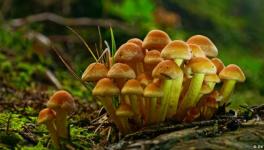Asteroid Collision That Led to Dinosaurs’ Extinction Helped Tiny Lichens to Bloom

Image for representational use only.Image Courtesy : Science Daily
In the 6 billion years of its existence, planet Earth has witnessed many change and many life forms. One of the most crucial of such changes was the mass extinction that took place in the Cretaceous – Paleogene (K-Pg) boundary some 66 million years ago. This mass extinction had a profound effect on the stages of biodiversity of the world, in fact, most of the present-day biodiversity started from there. It was also the event that wiped out many prevailing species, including the giant dinosaurs.
The K-Pg mass extinction event is also attributed to an asteroid collision, which created huge swathes of dust in the atmosphere that shielded the sun rays from penetrating to the Earth’s surface, cooling down the planet. As a consequence, many species that need light for their survival became extinct—dinosaurs, birds, plants, etc.
Nevertheless, this climatic change was not the end of life and many other life forms actually emerged after this event and could participate in new roles in the changed ecosystem. Among such organisms were the fungi, which live on dead stuff and that too without energy from the sun. Fossil records now reveal an increase in fungal spores during that time. Interestingly, along with fungi, another tiny life not only survived but started blooming during that period, tiny lichens.
Lichens are two different species living symbiotically—the fungi and plants. This peculiarity of lichens intrigued scientists to search what effect did the mass extinction have on them—were they affected negatively like the plants or were they affected positively like the fungi. The results of one such study has been published recently in the Nature journal Scientific Reports. The study found that lichens seized the moment and evolved into more diversified forms and took up plants’ role in the ecosystem.
The results of the study put the scientists in surprise, because what they expected was completely opposite to what they found. Jen-Pang Huang, the first author, said—“We originally expected lichens to be affected in a negative way, since they contain green things that need light.”
To find out how the lichens got affected by the mass extinction, the scientists had to design their experiments quite creatively. Fossil records of lichens of that time are very scarce to get any evidence from. But, they had ample DNAs of modern lichen DNA. From observing fungi growing in the lab, the scientists could decipher the mutation rate in those fungi. The mutation rate is how frequently the gene sequences of any organism get altered. The knowledge of the mutation rate and comparing DNA sequences of two organisms, it could be revealed how long ago these two organisms had a common ancestor with the same DNA.
The researchers took out DNA of three families of lichens and fed them into a software programme that compared their DNA and figured out how long ago they deviated from a common ancestor. They strengthened this information with the few lichen fossils of 100 and 400 million years ago that they have. Their results indicated that a lichen boom could be traced back to 66 million years ago—the time of the asteroid collision and the eventual mass extinctions. Some lichens grow sophisticated 3D structures like plant leaves, and these ones filled the niches of plants that died out. Some groups don’t show a change indicating that they neither benefited nor suffered from the changes that engulfed the environment.
The results are not only interesting from the point of view of lichen evolution, but it is also important in the sense that it underlined how profoundly the natural world that we know today was shaped by the mass extinction.
Thorsten Lumbsch, senior author of the study and the Field Museum’s curator of lichenised fungi, said –“If you could go back 40 million years, the most prominent groups in vegetation, birds, fungi -- they'd be more similar to what you see now than what you'd see 70 million years ago. Most of what we see around us nowadays in nature originated after the dinosaurs."
Moreover, the study also shed light on how species will respond to the mass extinction that the planet is currently undergoing, since it shows how lichens responded to the mass extinction 66 years ago. “Before we lose the world's biodiversity, we should document it, because we don't know when we'll need it," says Huang, the first author. He also added, "Lichens are environmental indicators -- by simply doing a biodiversity study, we can infer air quality and pollution levels."
Get the latest reports & analysis with people's perspective on Protests, movements & deep analytical videos, discussions of the current affairs in your Telegram app. Subscribe to NewsClick's Telegram channel & get Real-Time updates on stories, as they get published on our website.


















